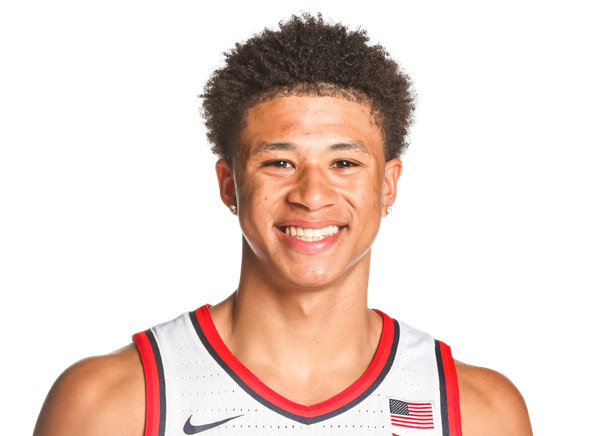Full Analysis
Offense
Carter Bryant’s offensive role at Arizona was deliberately narrow, but his performance within that role suggests real potential as a prototypical 3-and-D wing. Used primarily as a play-finisher, Bryant thrived off spot-up jumpers, transition opportunities, and smart off-ball movement. While his counting stats were modest due to a limited role and sub-50% minute share, his efficiency and feel were impactful within Arizona’s system.
Spot-up shooting is currently his most bankable offensive skill. He ranked in the 71st percentile in spot-up possessions (1.043 PPP), and 66th percentile (1.09 PPP) on catch-and-shoot jumpers overall. Importantly, he performed well even on guarded attempts as 75.7% of his catch-and-shoot attempts were contested, and he still produced in the 61st percentile. Bryant’s mechanics are clean with a high release, and though his shot can be slightly slow off the catch, it’s a projectable foundation. His 88.3% free-throw mark as a high school senior adds further confidence to his shooting development.
He offers limited scoring dynamism at this stage. Bryant attempted just 15 pull-up jumpers all season and posted a turnover rate (18.9%) far higher than his assist rate (8.6%). He isn’t comfortable creating out of pick-and-roll or isolation, which made up less than 10% of his offensive usage. His handle is functional but raw, with a loose dribble and limited shake. When attacking closeouts, he can lose control or default to a basic drive, often without a plan.
However, Bryant adds clear value off the ball. His cutting is instinctive and purposeful, and he ranked in the 97th percentile in at-rim finishing in the halfcourt, converting nearly 79% of such attempts. He uses his strength well to finish through contact and is athletic enough to rise over weakside defenders when finishing on cuts or lobs. He also crashes the offensive glass and creates second-chance opportunities with energy and physicality.
There are flashes of secondary creation, particularly as a connective passer. Though his assist numbers are modest, film reveals a willingness and ability to make simple, accurate reads, particularly on short rolls or drive-and-kick actions. While not an initiator, he shows potential as a tertiary decision-maker, especially in drive-and-react or handoff scenarios.
Growth areas include tightening his handle, developing a quicker release on movement threes, and improving his ability to make plays off the bounce. While he’s unlikely to be a high-usage option, refining his ancillary tools could allow him to thrive as a versatile third or fourth offensive option in the NBA.
Defense
Bryant’s defensive profile is where his first-round case solidifies. He’s one of the most versatile and fundamentally sound defenders in the class, capable of guarding multiple positions with a good mix of strength, explosiveness, and anticipation.
At 6 '6.5 " with a 7' 0” wingspan and a well-built frame, Bryant checks the physical boxes for a modern NBA wing defender. His lateral movement and balance are advanced for his age, allowing him to stay in front of guards, absorb contact from wings, and even handle some small-ball bigs in switches. He plays low in his stance, consistently slides his feet, and walls up on drives using his chest and core strength.
His on-ball defense is complemented by high-level instincts as a help and weakside defender. Bryant excels in rotations, tags rollers on time, and is a legitimate weakside rim protector. His block rate (6.0%) is good for a wing, and his 2.7 STL% adds further to his defensive event creation. He consistently disrupts passing lanes, alters shots with vertical contests, and reads the floor at a high level.
His defensive discipline is mostly impressive, but he can be overzealous, particularly when hunting blocks. His foul rate is high, more in line with bigs than wings, and mitigating unnecessary reaches and late contests will be a key developmental area. That said, the overall motor and anticipation are excellent.
Importantly, Bryant’s defensive impact showed up in Arizona’s team metrics. With him on the court, Arizona posted a 94.1 defensive rating (15th percentile nationally). Without him, that rating slipped to 97.3 (35th). His DBPM of 4.6 ranked fourth among all freshmen nationally.
Bryant projects as a switchable, multi-positional defender who can lock down isolation possessions, rotate as a helper, and generate turnovers. He’s likely to make an immediate impact on that end in the NBA, especially in structured schemes that emphasize communication and off-ball awareness.
Looking Ahead
Carter Bryant may not project as a star or on-ball creator, but he exemplifies the traits of a long-term, high-impact role player, perhaps even an elite one. His defense is ready for NBA minutes. He guards multiple positions, competes on every possession, and delivers both on-ball containment and help-side value. On offense, he’s a reliable play-finisher with real spot-up equity and some untapped upside as a passer and secondary scorer.
His ceiling will be determined by how far his offensive game can evolve. If he improves his handle and quickens his shooting release, he could grow into a connective wing who can attack closeouts, hit movement threes, and pass on the move. Even without that development, Bryant’s floor as a 3-and-D wing who contributes to winning basketball is high.
Given the scarcity of wings with his frame, shooting profile, and defensive chops, he should be on every lottery team’s radar. A team with strong offensive creators that needs a versatile defensive wing would be an ideal developmental environment.



